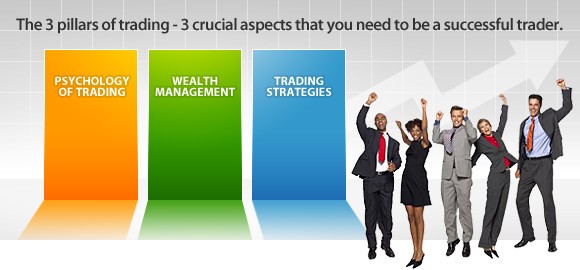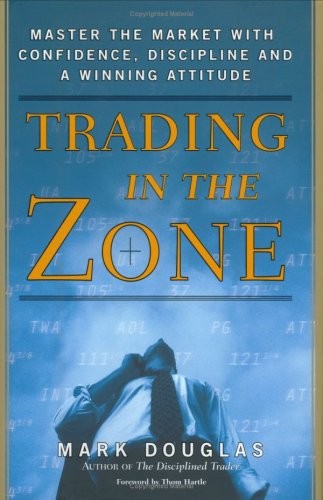Trading Psychology How to Think Like a Trader
Post on: 6 Июль, 2015 No Comment

Trading its all about using your brain to analyze the options and then make the best decisions, right?
You might hear that from a trader at a cocktail party when hes trying to impress people, but most traders know that psychology plays a huge role.
Some traders would go as far as saying that psychology and emotions are 80% of the battle.
Do not overestimate your ability to be unaffected by emotion.
Real Life vs. the Trading Floor
Even if you’ve been a calm, analytical guy or gal most of your life, don’t assume that youll be able to stay relaxed on the trading floor.
The pressure and stress youll face will be far greater than anything you’ve ever experienced especially if youve only been a student before.
When I first started trading, I was confident of my math and analytical skills so I thought I could base all my trading decisions purely on analysis, unaffected by emotion.
Nothing could be further from the truth to see why, lets walk through the emotions of a trade.
Trading Highs and Lows
This example is actually a short series of trades that spans one trading day but similar emotions can occur over weeks or even months.
9:30 AM: You watch as the market opens. You are looking for a good buy entry point into Microsoft [MSFT] because they are going to announce earnings shortly after the market close today, and based on your analysis you think that they’re going to beat analyst expectations and that institutional buyers will load up on the stock throughout the day.
10:30 AM: MSFT inches upward for an hour, and then takes a small dip. You think, Great chance to buy on the dip! Originally you were planning to buy 20K shares, 10K for intra-day trading and 10K for holding until after the earnings announcement.
20K shares? That means even if you successfully catch a $1 stock price move, you only make a measly $20K? Better double that.
You buy 40K shares of MSFT at $28.50 (Emotion: greed ), contrary to your initial plan and risk guidelines. Based on your technical analysis, you plan to take profits on half of your shares at $28.80 and cut losses at $28.20.
11:00 AM: The broader market (that is, the S&P 500 index) zooms upward based on bullish comments by one of the regional Fed governors. MSFT zooms upwards along with the broader market. $28.60. $28.70. $28.80. youve reached your profit-taking point!
But wait! You don’t take profits yet (Emotion: greed ) The rally isnt over. $28.90..$29.00..$29.10. sweet! This is awesome! (Emotion: elation ) Youre not sure why its going up this far, but who cares?
Youre making money. You pat yourself on the back. Maybe youll buy yourself an expensive lunch to celebrate.
11:15 AM: MSFT’s rally starts to weaken. then it starts to move sideways. Cmon, this rally has got to have another leg up, right? (Emotion: hope )
Then MSFT starts to fall slowly $29.00 $28.90 Well, that doesnt mean the rally is over, right?
Your technical indicators tell you a falling trend has began, but your heart tells you that this could be just a slightly oversized downward correction and that the rally hasnt ended yet (Emotion: denial ).
11:30 AM: MSFT starts to trend down further. $28.50 $28.30 You want to bash your head against your keyboard. Why didnt you sell earlier? Why is this dropping so much anyway?
Some %^$^*%@# hedge fund must be short-selling huge amounts to manipulate the price. Its not fair that hedge funds are bigger than I am. (Emotions: anger, frustration ).
$28.20 $28.10 youve hit your stop loss point but you fail to hit the sell button. After all, MSFT was having a great day. Surely the price will bounce back up eventually? (Emotion: hope )
11:45AM: $27.60…$27.50… the selling spree is not relenting. You minimize the window that shows your losses because it is too painful to watch. Why didnt you sell earlier?
Youve just erased everything youve made from weeks of trading. How are you going to ever make this money back? (Emotion: despair )
You stop caring about how much MSFT drops (Emotion: resignation ). It’s already a huge loss anyway whats a couple more thousand matter anyway?
1:00 PM: $26.80 your technical analysis indicators show that right now may be a good buy entry point.
You know that you already have 40K shares and you cant afford to take any more risk. But you are mad at MSFT and you want to get revenge.

Your boss is probably going to yell at your later anyway, so you might as well go all out. You double down and buy another 40K shares, bringing your total share count to 80K (Emotion: desperation ).
1:30 PM: MSFT starts to nosedive. Wait, what. MSFT dropped 20 cents in 10 seconds. $26.20 $26.10 What is going on? What are you going to do? (Emotions: panic, fear )
You cringe as you submit a market order to sell all of your 80K shares at $26.10. Almost immediately after you sell, MSFT stops nosediving and recovers slightly.
You sold your shares at the worst possible price; if you werent so panicked, you could have divided your order into chunks and used limit orders and achieved better price execution. You want to cry. You are a failure. (Emotion: depression )
4:15 PM: You spend the rest of the trading day wallowing in misery without making trades. Shortly after the market close, MSFT announces blowout earnings and it shoots up to over $30.00.
You stare in disbelief but there is nothing you can do now if only you had followed your initial plan (Emotions: helplessness, regret ).
If You Could Do It All Over
What would an experienced trader have done in the above situation?
Actually, even experienced traders are affected by emotion Ive seen a white-haired trader at a bulge bracket investment bank turning red, swearing his head off, and pounding at his keyboard but Ive also met a trader in his early 30s who never once lost his cool.
So the question should be, What should this trader have done in the ideal scenario?
In this example, the trader should have followed his own plan and rules strictly he should have stayed within his risk limits, sold the stock when the price hit the pre-determined stop-loss level, and he should have taken his profits when the stock reached the pre-determined profit-taking level.
In short, he should have sold immediately when the stock hit $28.80 yes, thats only a profit of $12,000. but its way better than losing $124,000 as this trader did.
Experienced traders know when to break their own rules because they have the discipline to not break the rules too often and to keep the risk-taking from getting out of hand.
Traders without such discipline such stick to strictly to their rules to protect themselves. As the saying goes, plan your trades, and trade your plan.
And if all else fails, you can just get your own trading stress bracelet .














